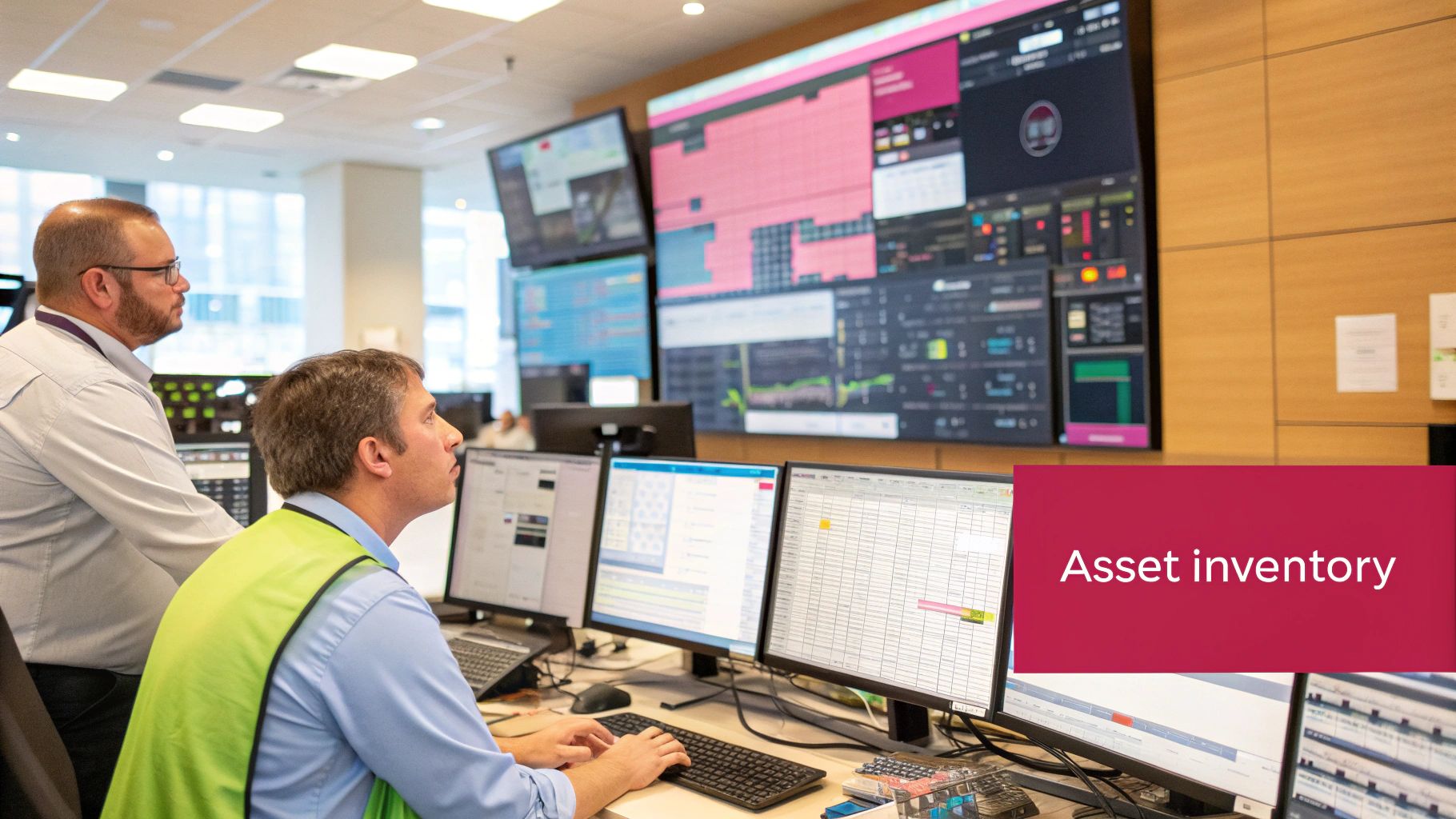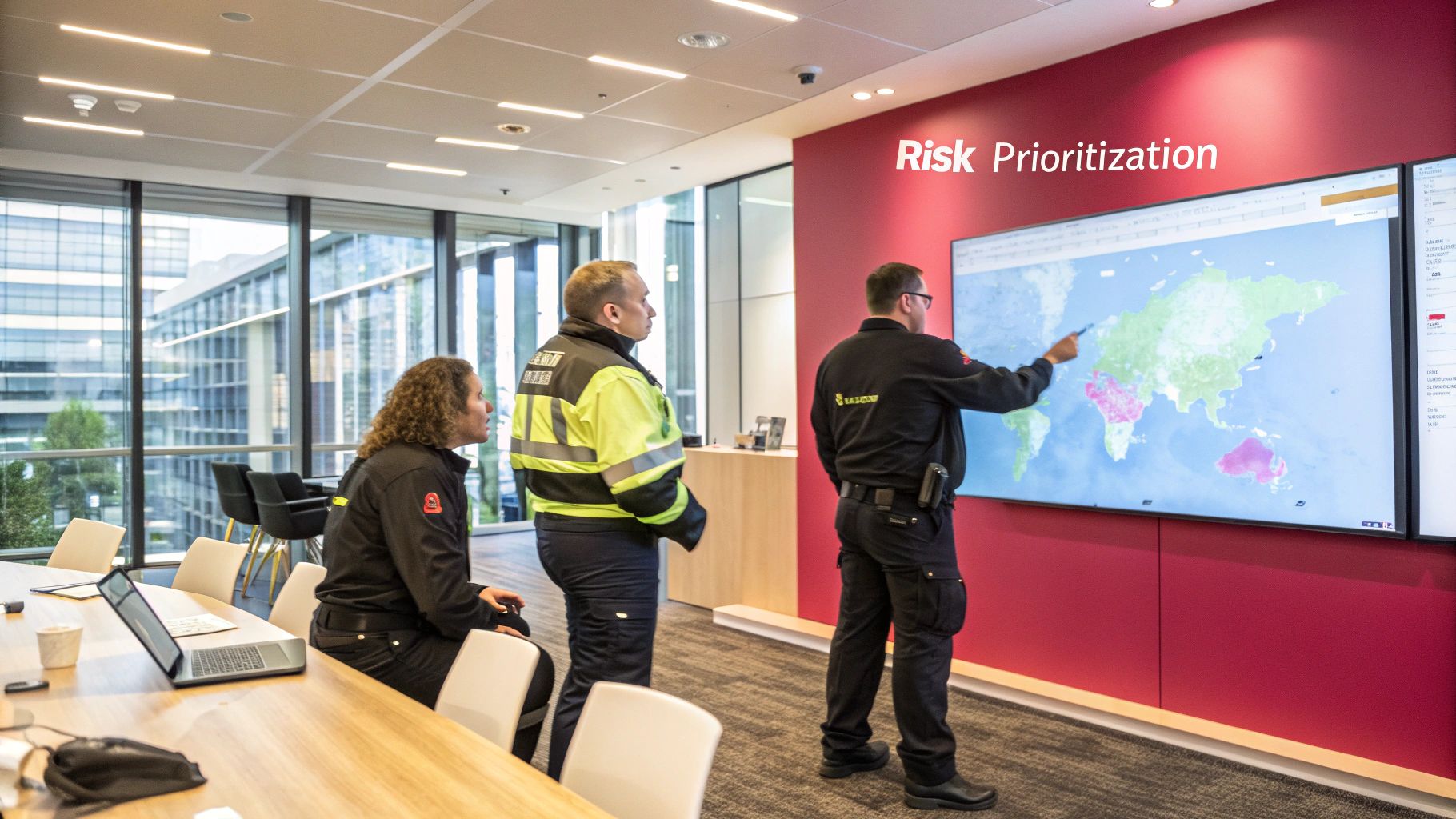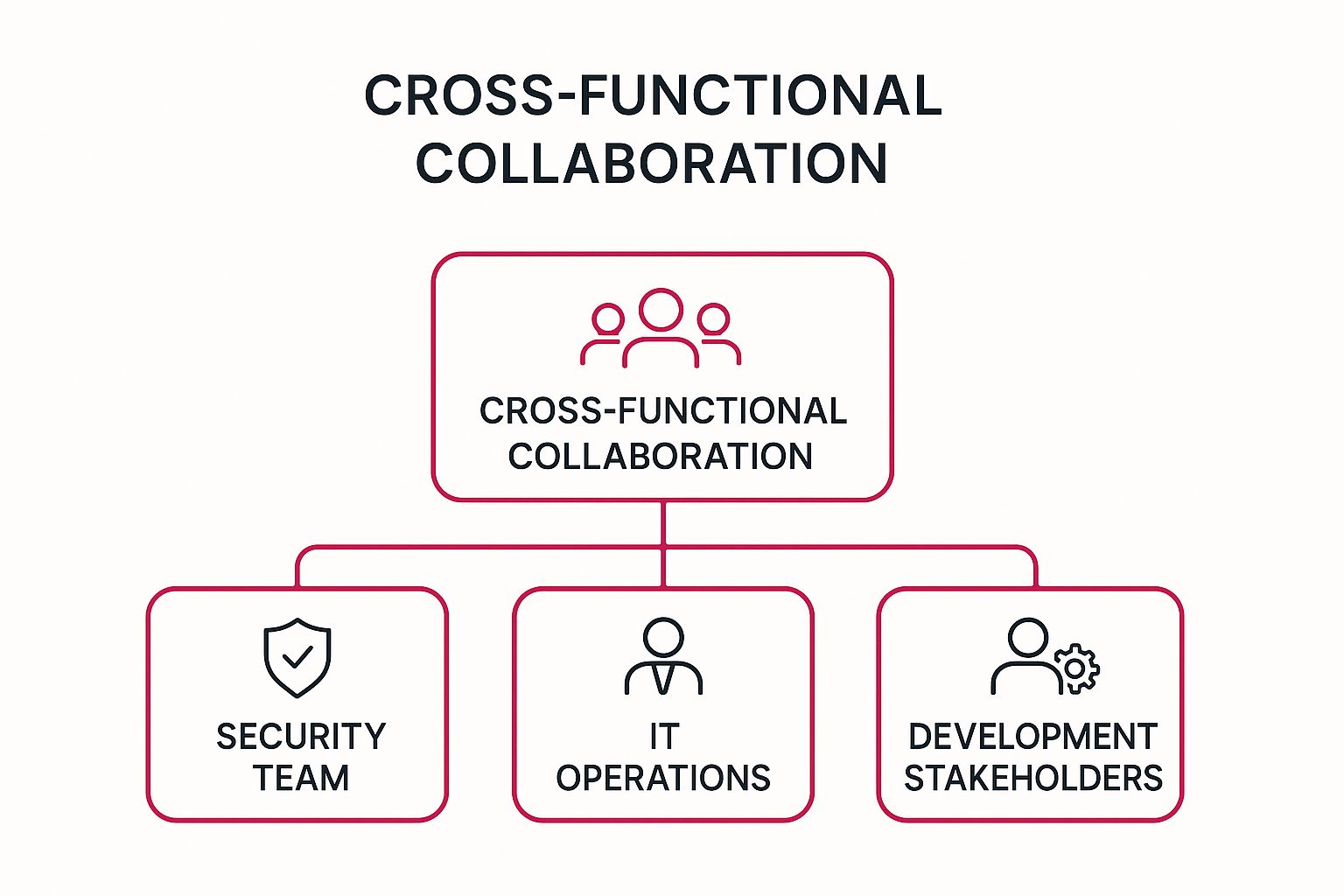8 Vulnerability Management Best Practices for 2025
In today's complex digital landscape, identifying and neutralising cyber-security threats before they can cause damage is no longer optional, it's essential for survival. For professional services firms and other small and medium-sized enterprises (SMEs) across regions like Dorset and Hampshire, the challenge is particularly acute, balancing limited resources with the need for robust protection. A structured approach to vulnerability management is the cornerstone of a resilient security posture, transforming cyber-security from a reactive scramble into a proactive, strategic discipline.
This guide moves beyond generic advice to outline eight essential vulnerability management best practices. We provide actionable insights and practical examples tailored for UK businesses, from accountancy firms to legal practices. Following these principles helps you methodically reduce your attack surface and safeguard critical assets. For example, a core aspect of protecting sensitive client data involves robust practices for handling credentials, ensuring you implement strong measures for securely storing passwords in your database as part of a wider security strategy.
By implementing these proven strategies, you can not only fortify your defences against potential breaches but also ensure regulatory compliance and build lasting trust with your clients. Let's explore the steps to build a more secure and resilient organisation.
1. Establish Continuous Asset Discovery and Inventory Management
A robust vulnerability management programme starts with a simple, foundational principle: you cannot protect what you do not know you have. Establishing continuous asset discovery and maintaining a comprehensive inventory is the critical first step. This practice involves automatically identifying and cataloguing every piece of hardware, software, cloud instance, and network device connected to your organisation's environment. Without a complete and up-to-date inventory, unseen assets create dangerous blind spots, rendering your security efforts incomplete.

This process is fundamental because it provides the complete scope for your vulnerability scanning and remediation efforts. It is not just about listing servers and laptops; it includes tracking transient cloud resources, temporary virtual machines, and the growing challenge of "shadow IT"—unsanctioned devices and applications used by employees. For a financial advisory firm, this could mean discovering an unsanctioned cloud storage account used to share client documents. By maintaining a real-time view of your entire IT estate, you ensure that every potential entry point for an attacker is monitored. A detailed understanding of your technology landscape is also a key component of effective IT asset management.
How to Implement This Practice
For professional services firms, the approach can be scaled effectively:
- Start Incrementally: Begin by mapping your most critical business systems. For an accountancy practice, this would include servers hosting client tax records or financial applications. Gradually expand your discovery efforts outwards from there.
- Tag Assets with Context: Do not just list an asset; enrich its inventory entry with crucial business context. For instance, tag a laptop with its assigned user (e.g., Senior Partner), physical location (e.g., London office), business function (e.g., client relationship management), and the sensitivity of the data it handles. This helps prioritise remediation efforts later.
- Automate Discovery: Implement a combination of active scanning and passive network monitoring. Passive discovery listens to network traffic to identify assets without disruption, which is ideal for sensitive operational environments like a busy legal firm during court season.
- Manage Unauthorised Devices: Use Network Access Control (NAC) to identify and quarantine unauthorised devices as they attempt to connect to your network. Establish a clear process for handling discovered shadow IT, whether it involves sanctioning the asset or removing it from the network.
2. Implement Risk-Based Vulnerability Prioritisation
Attempting to patch every discovered vulnerability is an inefficient and often impossible task. A more strategic approach is to implement risk-based vulnerability prioritisation, a core component of modern vulnerability management best practices. This methodology shifts the focus from simply relying on generic severity scores (like CVSS) to a more nuanced evaluation of the actual risk a vulnerability poses to your specific business operations. It considers multiple factors, including asset criticality, active exploitation in the wild, and potential business impact.

This practice acknowledges that not all "critical" vulnerabilities require immediate attention, while some "medium" ones could be catastrophic depending on the context. A prime example for a professional services firm would be a medium-severity flaw in a client portal versus a critical flaw in an internal-only development server. The former poses a much greater immediate risk to client data and the firm's reputation. By focusing your limited IT resources on the flaws that pose the greatest genuine threat, you can significantly reduce your organisation's attack surface far more effectively than with a 'patch everything' approach.
How to Implement This Practice
Professional services firms can adopt a scalable, risk-based strategy:
- Integrate Threat Intelligence: Start with CISA's Known Exploited Vulnerabilities (KEV) catalogue. If a vulnerability is on this list, it is being actively used by attackers and should be your highest priority.
- Layer in Context: Combine the CVSS score with metrics like the Exploit Prediction Scoring System (EPSS), which estimates the probability of a vulnerability being exploited. This provides a more accurate picture of real-world risk.
- Tier Your Assets: Categorise your assets based on their business impact (e.g., critical, high, medium, low). A medium-severity vulnerability on a critical client database in your Dorset office is more urgent than a critical flaw on a non-essential test server.
- Consider Compensating Controls: Assess whether existing security controls, like a web application firewall (WAF) or network segmentation, reduce the likelihood of a specific vulnerability being exploited. For instance, if a server vulnerability exists but that server is only accessible from a secure internal network, the immediate risk is lower.
3. Establish Clear SLAs and Remediation Timelines
A core component of effective vulnerability management best practices is moving from discovery to action. Defining and enforcing service-level agreements (SLAs) for remediation creates the necessary accountability and urgency. This practice involves setting specific, non-negotiable timeframes for patching or mitigating vulnerabilities based on their severity level and the criticality of the affected asset. Clear SLAs prevent dangerous vulnerabilities from languishing unaddressed and align security and IT operations teams with a shared set of priorities.
This framework is fundamental because it transforms vulnerability scanning results from a simple list of problems into an actionable, time-bound work plan. It answers the critical question, "What needs to be fixed, and by when?" Without formal SLAs, remediation often becomes a best-effort activity, easily de-prioritised by competing operational tasks. For example, a consulting firm can demonstrate due diligence to clients by showing it adheres to a policy of fixing all critical vulnerabilities within 14 days, a requirement that helps satisfy compliance frameworks like ISO 27001.
How to Implement This Practice
Professional services firms need a disciplined approach to remediation:
- Establish a Tiered Timeline: Create a simple, tiered SLA structure as a starting point. A common framework is: Critical vulnerabilities within 15 days, High within 30 days, Medium within 60 days, and Low within 90 days or at the next scheduled maintenance window.
- Automate Tracking and Notifications: Use your vulnerability management platform to automatically track SLA deadlines. Configure automated alerts for IT teams when a vulnerability is approaching or has breached its remediation timeline, reducing manual oversight.
- Define an Exception Process: Not all systems can be patched immediately without disrupting business operations. For example, patching a core case management system at a law firm may need to wait for a weekend. Create a formal exception process where system owners must request an extension and document compensating controls, such as enhanced monitoring, to mitigate the risk in the interim.
- Integrate SLAs into Performance Reviews: Drive accountability by including SLA compliance metrics in team and individual performance reviews for both security and IT operations staff. This reinforces the message that timely remediation is a shared and critical business responsibility.
4. Integrate Vulnerability Management into DevSecOps
Traditional security models often treat vulnerability assessment as a final step before deployment, creating a bottleneck that slows down delivery. A modern approach integrates security directly into the software development lifecycle (SDLC), a practice known as DevSecOps. This "shift-left" strategy involves building security into applications from the very beginning, empowering developers to find and fix vulnerabilities as they write code, rather than discovering them in production when they are far more costly and difficult to resolve.

By making security a shared responsibility, DevSecOps transforms vulnerability management from a reactive, gate-keeping function into a proactive, collaborative process. For a firm developing a bespoke client portal, integrating security tools into the CI/CD pipeline means every code commit can be automatically scanned for known vulnerabilities, misconfigurations, and weaknesses. This continuous feedback loop not only accelerates remediation but also improves the organisation's overall security posture, reduces the risk of deploying vulnerable code, and aligns security efforts with the fast pace of modern development.
How to Implement This Practice
These principles are adaptable for any organisation developing software, including professional services firms with in-house development teams:
- Start with Dependencies: Begin by implementing Software Composition Analysis (SCA) tools to automatically scan for vulnerabilities in open-source libraries and dependencies—a common entry point for attackers.
- Automate in the Pipeline: Integrate Static Application Security Testing (SAST) tools into your CI/CD pipeline to analyse source code before it is compiled. Configure these tools to initially fail builds only on high or critical severity issues to avoid overwhelming developers.
- Empower Developers: Provide developers with IDE plugins that offer real-time security feedback as they code. Equip them with clear remediation guidance, not just alerts, and establish robust code review best practices to catch security flaws early.
- Build Security Champions: Create a "security champions" programme by identifying and training developers who are passionate about security. These individuals can act as security advocates within their teams, providing guidance and fostering a security-conscious culture.
5. Perform Regular Vulnerability Scanning with Comprehensive Coverage
Conducting regular, automated vulnerability assessments across all IT assets is essential for identifying security weaknesses before attackers can exploit them. This practice involves deploying vulnerability scanning tools that systematically examine systems, applications, networks, and cloud infrastructure for known vulnerabilities, misconfigurations, and security gaps. It is a proactive, foundational element of any effective vulnerability management programme, moving beyond passive defence to actively hunt for potential flaws.
Comprehensive coverage is the goal, requiring scans of both internal and external-facing assets, as well as authenticated and unauthenticated systems, to gain a complete picture of your risk posture. While a vulnerability scan methodically checks for known issues, it differs from a more targeted, manual attack simulation. Understanding the difference between penetration testing vs vulnerability scanning is key to building a layered defence strategy. Regular scanning provides the continuous feedback loop needed to detect and address new threats as they emerge.
How to Implement This Practice
A professional services firm can adopt a scaled approach to achieve consistent coverage:
- Schedule Strategically: Run less-intrusive scans during business hours to maintain visibility without disrupting operations. Schedule more intensive, authenticated scans during planned maintenance windows (e.g., Sunday evenings) to minimise business impact.
- Use Agent-Based Scanning: For remote and mobile devices, such as laptops used by consultants who travel frequently, deploy agent-based scanners. These agents run locally and report back when the device reconnects, ensuring assets outside the office perimeter are not missed.
- Implement Authenticated Scans: Configure scanners with credentials to log into systems. This "authenticated" approach provides deeper visibility into installed software, patch levels, and specific service configurations, uncovering vulnerabilities that external scans would miss.
- Establish a Scanning Cadence: Start with a baseline of monthly scans for all assets. Increase the frequency for critical or internet-facing systems (like a client portal) to weekly or even daily, and ensure any new asset is scanned within 24 hours of its deployment to the network.
6. Implement Compensating Controls and Virtual Patching
In an ideal world, every identified vulnerability would be patched immediately. However, business reality often dictates otherwise; patches may require extensive testing, disrupt critical operations, or be unavailable for legacy systems. Implementing compensating controls and virtual patching is a crucial vulnerability management best practice that bridges this gap, providing a vital layer of protection when immediate remediation is not feasible. This approach involves deploying security measures like Web Application Firewalls (WAFs) or Intrusion Prevention Systems (IPS) to block exploit attempts against a known vulnerability, effectively creating a "virtual patch".
This strategy acknowledges that patching can be a complex process and provides a pragmatic way to manage risk without halting business functions. For example, a financial services firm running critical trading software that cannot be taken offline for patching can deploy a WAF rule to block a specific web-based attack vector. This proactive, temporary measure buys your IT team the time needed to follow a proper patch management lifecycle without leaving critical assets exposed.
How to Implement This Practice
Firms in professional services can adopt this strategy to maintain security and compliance:
- Treat as Temporary: View compensating controls as a short-term solution, not a permanent fix. Set calendar reminders and establish a firm timeline for applying the official patch.
- Layer Your Controls: For high-risk vulnerabilities, use multiple controls for defence-in-depth. For a vulnerable server, combine a WAF rule with enhanced monitoring and restricted user access for the affected system.
- Leverage Vendor Feeds: Subscribe to threat intelligence feeds from your IPS/WAF vendors. This allows you to deploy virtual patch signatures rapidly as soon as they become available for new threats.
- Document and Review: Maintain a clear record of all compensating controls, which system they protect, and the vulnerability they address. Review this log regularly to ensure controls are removed once permanent patching is complete.
7. Foster Cross-Functional Collaboration and Communication
Effective vulnerability management is not solely the responsibility of a dedicated security team; it is an organisational effort. Fostering cross-functional collaboration means breaking down the silos that traditionally exist between security, IT operations, development, and business leadership. This practice establishes shared ownership and clear communication channels, ensuring that everyone understands their role in protecting the organisation’s assets. Without this collaborative culture, remediation efforts are often delayed by conflicting priorities, and critical vulnerabilities can be overlooked, creating significant risk.
This approach transforms vulnerability management from a technical task into a shared business objective. When security, IT, and development teams work in isolation, they lack the complete context needed to prioritise effectively. For example, the IT team at an architectural firm might not grasp the urgency of patching a vulnerability in design software until the security team explains it could lead to the theft of valuable intellectual property. By creating a unified front, organisations can respond to threats more cohesively and efficiently, ensuring that one of the core vulnerability management best practices is embedded into the company culture.
The hierarchy diagram below illustrates the ideal collaborative structure, with a central goal connecting the key teams involved in the vulnerability management process.

This visualisation highlights how the Security, IT, and Development teams are not isolated pillars but interconnected partners working towards a common goal.
How to Implement This Practice
Professional services firms can build a collaborative security culture:
- Establish Regular Triage Meetings: Hold weekly or bi-weekly meetings with representatives from security, IT operations, and relevant business units (e.g., the head of the tax department) to review, prioritise, and assign new vulnerabilities.
- Create Shared Communication Channels: Use a dedicated Slack or Teams channel for real-time discussions about vulnerabilities. This ensures quick clarification and prevents important information from getting lost in email threads.
- Translate Technical Risk into Business Impact: When communicating with partners or directors, frame vulnerabilities in terms of potential financial loss, reputational damage, or regulatory fines rather than just technical severity scores. For example, "This flaw could expose our entire client database, risking a significant GDPR penalty."
- Define Clear Ownership: Ensure every asset, application, and system has a designated owner or team responsible for its remediation. This accountability is crucial for driving action.
- Provide Role-Specific Security Training: Equip your IT and development staff with training tailored to their roles. A developer needs to understand secure coding practices, while an IT administrator needs to know how to harden systems correctly.
8. Measure, Report, and Continuously Improve
A successful vulnerability management programme is not a "set and forget" activity; it is a dynamic cycle of assessment, remediation, and refinement. Establishing clear metrics, key performance indicators (KPIs), and regular reporting mechanisms is essential for demonstrating effectiveness and driving continuous improvement. This practice moves beyond simple vulnerability counts to provide meaningful insight into the programme’s health, efficiency, and overall impact on business risk.
Effective measurement connects your technical vulnerability management activities to tangible business outcomes, justifying security investments and providing crucial transparency to stakeholders. For a professional services firm, reporting a consistent reduction in the "mean time to remediate" critical issues from weeks to just days provides tangible proof to clients and insurers that the firm takes data protection seriously. This data-driven approach is fundamental to maturing your security posture and is increasingly required by cyber-security insurance providers before they will offer coverage.
How to Implement This Practice
Tracking the right metrics transforms your vulnerability management from a reactive chore into a strategic, proactive function.
- Define Meaningful KPIs: Focus on metrics that reflect efficiency and risk reduction, not just volume. Key KPIs include Mean Time to Remediate (MTTR), Mean Time to Detect (MTTD), SLA compliance rates, and scan coverage percentage.
- Track Vulnerability Trends: Monitor the age of open vulnerabilities and the overall "vulnerability density" (vulnerabilities per asset) over time. A decreasing trend indicates programme success, while a rising trend signals a need for investigation and process adjustment.
- Create Tailored Reports: Reporting is not a one-size-fits-all exercise. Develop separate dashboards for different audiences. The IT team needs granular data on specific vulnerabilities, while the firm's partners need high-level summaries that connect security performance to business risk and client trust.
- Conduct Regular Programme Reviews: Schedule quarterly reviews to analyse your KPIs, discuss challenges, and identify areas for improvement. Use this time to assess whether your processes, tools, and resource allocation are effective or if adjustments are needed to meet your security goals.
Vulnerability Management Best Practices Comparison
| Practice | Implementation Complexity | Resource Requirements | Expected Outcomes | Ideal Use Cases | Key Advantages |
|---|---|---|---|---|---|
| Continuous Asset Discovery & Inventory | High – requires integration and ongoing maintenance | High – tools, integration, and skilled staff | Complete asset visibility and reduced blind spots | Organisations needing real-time asset coverage | Improves risk assessments and compliance |
| Risk-Based Vulnerability Prioritisation | High – needs sophisticated tools and expertise | Medium-High – threat intel, data integration | Focused remediation on highest actual risk | Environments with limited resources prioritising risk | Maximises impact and reduces alert fatigue |
| Clear SLAs and Remediation Timelines | Medium – policy definition and enforcement | Medium – governance, monitoring, reporting | Timely vulnerability remediation and accountability | Organisations requiring compliance and accountability | Creates measurable security performance |
| DevSecOps Integration | High – complex toolchain integration and culture shift | High – security tooling, developer training | Early vulnerability detection and faster fixes | Development environments aiming for secure SDLC | Reduces remediation costs and accelerates dev |
| Regular Vulnerability Scanning | Medium – deployment and scheduling of scans | Medium – scanning tools, credential management | Systematic vulnerability discovery and compliance | Organisations needing routine, broad asset scanning | Supports compliance and trend analysis |
| Compensating Controls & Virtual Patching | Medium – technical controls and tuning | Medium – expertise for configuration and monitoring | Temporary risk reduction until patching is possible | Legacy systems, urgent fixes, or patching delays | Immediate protection and business continuity |
| Cross-Functional Collaboration & Communication | Medium – requires coordination and culture change | Medium – time investment, communication tools | Faster remediation and shared security ownership | Enterprises seeking to break silos between teams | Enhances coordination and accountability |
| Measure, Report, and Continuously Improve | Medium-High – requires metrics, tooling, analysis | Medium – reporting tools and analysis effort | Data-driven improvements and leadership alignment | Mature programmes focusing on optimisation and justification | Demonstrates value and supports budget decisions |
Partnering for Proactive Protection
Embarking on a journey to build a mature vulnerability management programme is a transformative step for any organisation. It is a move away from reactive, incident-driven security towards a proactive, strategic defence. Throughout this guide, we have explored the essential pillars of a robust strategy, transforming abstract concepts into a concrete roadmap for businesses in Dorset, Somerset, and beyond.
The core message is clear: effective vulnerability management is not a single tool or a one-off project. It is a continuous, integrated cycle that requires a deep understanding of your unique digital environment. From the foundational step of establishing continuous asset discovery to ensure you know what you need to protect, to the strategic application of risk-based prioritisation that focuses your efforts where they matter most, each practice builds upon the last. We have seen how defining clear SLAs creates accountability and how integrating security into DevSecOps makes it an inherent part of your development lifecycle, rather than an afterthought.
From Process to Organisational Resilience
Mastering these concepts elevates cyber-security from a technical task to a core business enabler. Implementing comprehensive vulnerability scanning, utilising compensating controls for unpatchable systems, and fostering cross-functional collaboration breaks down the silos that so often hinder effective security. This collaborative approach ensures that your security efforts are aligned with business objectives, turning your IT department from a cost centre into a strategic partner in organisational resilience.
The final, crucial piece of the puzzle is the commitment to measure, report, and continuously improve. The threat landscape is not static; it evolves daily. A successful programme, therefore, cannot be static either. By tracking key metrics and regularly refining your processes, you build a resilient security posture that adapts and strengthens over time. This dedication to implementing vulnerability management best practices is what separates compliant organisations from truly secure ones. It is a fundamental investment in your company’s longevity, operational stability, and reputation.
For many professional services firms, dedicating the necessary internal resources to this constant cycle can be overwhelming. This is where a strategic partnership becomes invaluable. By leveraging external expertise, you can implement a world-class vulnerability management programme without diverting focus from your core mission. Embracing this proactive stance is the most powerful step you can take to secure your digital future.
Ready to transform your approach to cyber-security? Partner with SES Computers to implement these vulnerability management best practices with expert guidance and support. Discover how our tailored managed IT and cyber-security services for businesses across Dorset, Somerset, Wiltshire, and Hampshire can protect your organisation by visiting us at SES Computers.